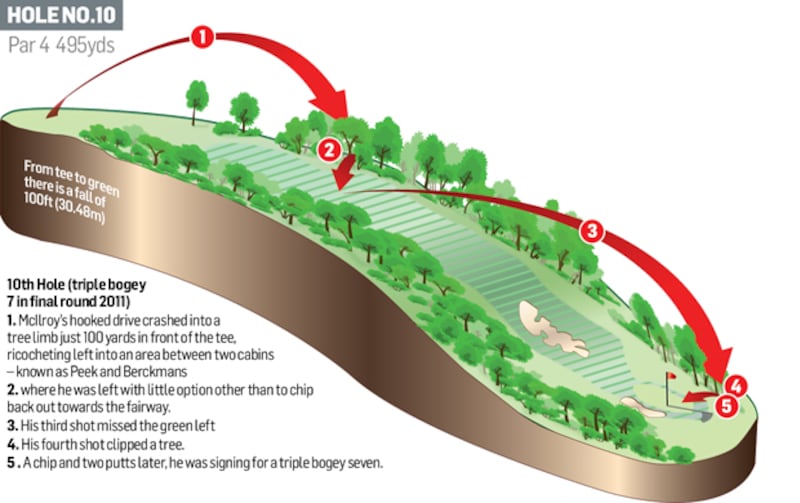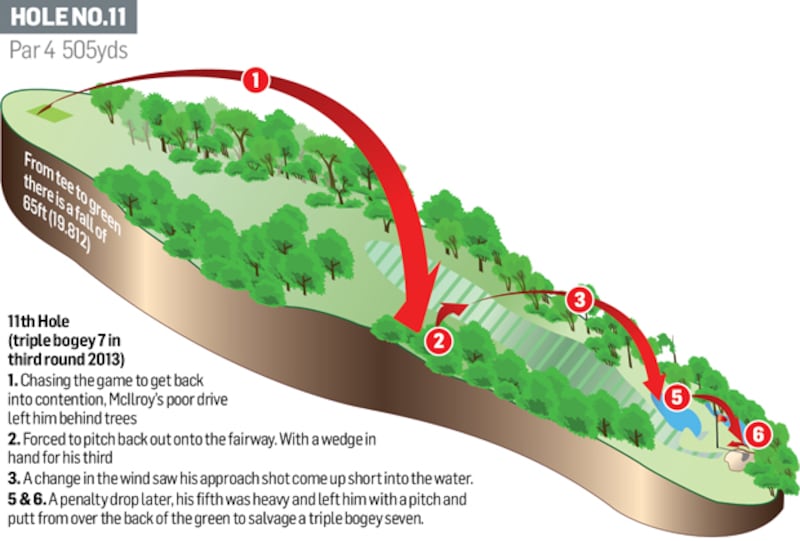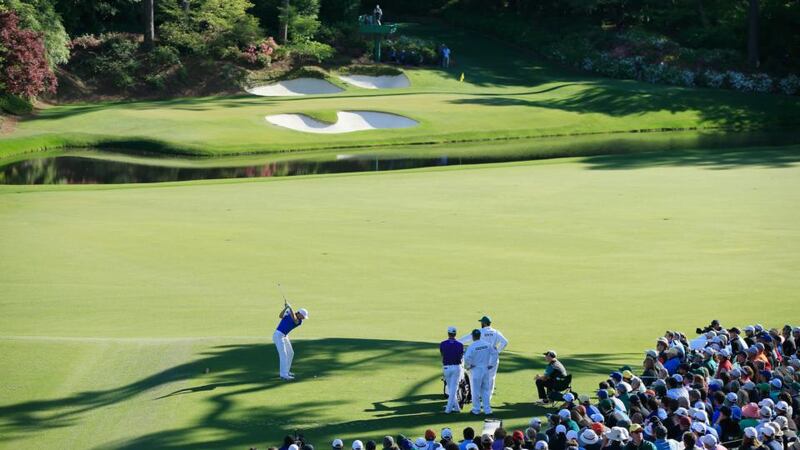In this case, what you see is definitely what you get. The topography of Augusta National is remarkable, with a fall of some 175 feet from its highest point – the first tee – to the aesthetic water hazard called Rae’s Creek which meanders its way from the 12th green up to the front of the 13th in that piece of real estate known as Amen Corner.
There are plenty of such physical highs and lows, with arguably the smaller mounds on the fairways presenting players with on-course obstacles of downhill, uphill and sideway stances for their approach shots causing bigger challenges. There are also mental variances which anyone attempting to conquer the course must negotiate.
Rory McIlroy knows this only too well, with some holes proving persistent thorns in his quest for a green jacket, the only Major title to so far evade his grasp.
I think this talk that, 'Oh, his game is suited to winning at Augusta, his game is perfect for Augusta', is very dangerous talk
As you would expect from a player whose primary strength is his driving, McIlroy has finally discovered a way to use the par 5s to his advantage. From a situation in 2014 where he finished level par over the four rounds on the par 5s, the Northern Irish man found the secret in the past two tournaments. In 2015, he was a combined 14 under par on the par 5s, while last year was 10 under par for those highs. They’re now his go-to holes for scoring.
“I feel like if I can go into Augusta knowing what my game plan is and knowing I can attack the par-5s and if I can play them well, it will give me a better chance to win,” McIlroy says.
Unfortunately, there are holes which have proven problematic. It’s hard to credit, but McIlroy – who first played the Masters in 2009 when he had a mop of curly hair and a less-defined physique which has been transformed through his gym programme – has never birdied the first hole. He has had 30 attempts with a card in his back pocket and has never birdied the opening par 4.
Two others holes have also caused him considerable grief: the 10th and the 11th, both of which are par 4s. That McIlroy should have his problems on these two holes is hardly surprising, given that the 10th and 11th historically are rated one and two respectively in the ranking of the toughest holes on the course. The 10th has an average score of 4.31 and the 11th an average score of 4.29, which effectively means one is as tough as the other.
McIlroy’s meltdown on the 10th hole in the 2011 Masters – when he had started with a four-stroke lead and was seemingly on course to win – has itself found its way into the annals of the tournament’s history. That triple-bogey seven was the tipping point, and once he fell over the cliff, there was no safety net and no route back to the top.

That spectacular fall by McIlroy in the final round actually wasn’t the highest score ever recorded on the 10th hole. That honour, so to speak, belongs to Danny Lee who ran up a quintuple-bogey nine in a second round 81, when he missed the cut. The difference was that Lee’s carnage didn’t matter in the overall picture; McIlroy’s was almost as much the story as the fact that Charl Schwartzel triumphed.
The 11th hole, White Dogwood, is the start of Amen Corner, but it has grown into something of a monster. The addition of trees on either side of the fairway over the years has punished errant tee shots, but it is the approach shot, often with a long iron or hybrid, to a green that lines a pond that causes most difficulty.
McIlroy posted a triple-bogey seven on the 11th hole in 2013, but there have been four quintuple bogeys on the 11th hole over the years. Dow Finsterwald – the man who was deprived of a play-off with Arnold Palmer when given a two-stroke penalty for practising a putt during a round when walking off the green to the tee in the 1960 tournament – was first to feel its wrath. He posted a nine in 1952; Bo Wininger joined him on that mark in 1958, while William Moody III signed for a nine in 1980 and Charles Howell III (the last man to do so) recorded a nine in 2006.

There once was a time when the 11th hole was seen as a pushover, a gentle introduction to Amen Corner. All that changed in 2002 when added length transformed it.
The story goes that tournament chairman Hootie Johnson saw Phil Mickelson hit a booming drive which left him with a lob wedge to the green. Tom Fazio was commissioned to make sure that wouldn’t happen again. It hasn’t.
For McIlroy to slot that final piece of the jigsaw into his bid for a career Grand Slam, he has to do two things: continue his mastery of the par 5s and find a way to ensure that the 10th and 11th aren’t his Achilles’ heels. In last year’s Masters – when McIlroy finished joint 10th – the 10th and 11th holes combined to blot his scorecard by seven shots over the four rounds.
However, part of the lore of Augusta National is that it conjures up highs and lows like no other place. Take the par 3 12th, where Tom Weiskopf once ran up a score of 13 and which proved a watery grave for Jordan Spieth in last year’s final round.

While Weiskopf’s 13 is the highest recorded score on the hole, there have been three aces – Claude Harmon, William Hyndham and Curtis Strange – over the years. The story of Harmon’s hole-in-one is all the more notable for the fact that he was playing with Ben Hogan. As the crowd went wild and Harmon soaked it all in, Hogan didn’t say a word before hitting his tee-shot to the green and holing out for a birdie.
According to Don Wade's book Talking On Tour, the exchange between the players went as follows:
Hogan: “You know, Claude, I can’t remember the last time I made a two there. What did you make?”
Harmon: “Why, Ben, I made an ace.”
Hogan: “Oh, well, that’s great Claude.”
McIlroy might need some of that “wee ice man” mentality on this latest excursion into the highs and lows of Augusta National, perhaps aided and abetted by flying somewhat under the radar, given Dustin Johnson’s current supremacy in the game.
Paul McGinley, who will be in the commentary booth for Sky Sports at the Masters, believes the pressure of completing the career Grand Slam is what McIlroy has to master.
“I think this talk that, ‘Oh, his game is suited to winning at Augusta, his game is perfect for Augusta’, is very dangerous talk. And hopefully, he is not listening to any of that noise . . . they said that about Greg Norman, he never won a Masters. They said that about Ernie Els. He never won a Masters,” McGinley says.
“That’s dangerous talk and I am sure he is not listening to that. He knows how to play the golf course with the lead that he had [in 2011]. He knows how to play the course and he knows how to get it around there. And he has obviously got the heart to win Major championships. We have all seen that. He has all the skill set required to win around there. We all know that.
“The challenge for Rory is that he is on the threshold of history. And there is a reason why only five guys have won the Grand Slam: it is because it is such a big step up. Phil Mickelson hasn’t done it. He is still waiting on a US Open to complete it.
“It is a big, big, big mental challenge to get over that line and join the history of all time. And we have an Irish man standing on that threshold. That is the challenge for Rory.”
In his most recent visits, McIlroy has shown he has put the demons that followed him on the back nine of the final round in 2011 to bed. On his last three visits, McIlroy has secured three top- 10 finishes: tied 8th in 2014, solo fourth in 2015 and tied 10th in 2016. All highs, but just not high enough.
McIlroy – lightly raced this season due to his rib stress fracture – goes forth with another chance to find the missing link in his Grand Slam. Now, if only he could find a birdie on the first. And if only he can avoid any pitfalls on the 10th and 11th holes. If only . . .













